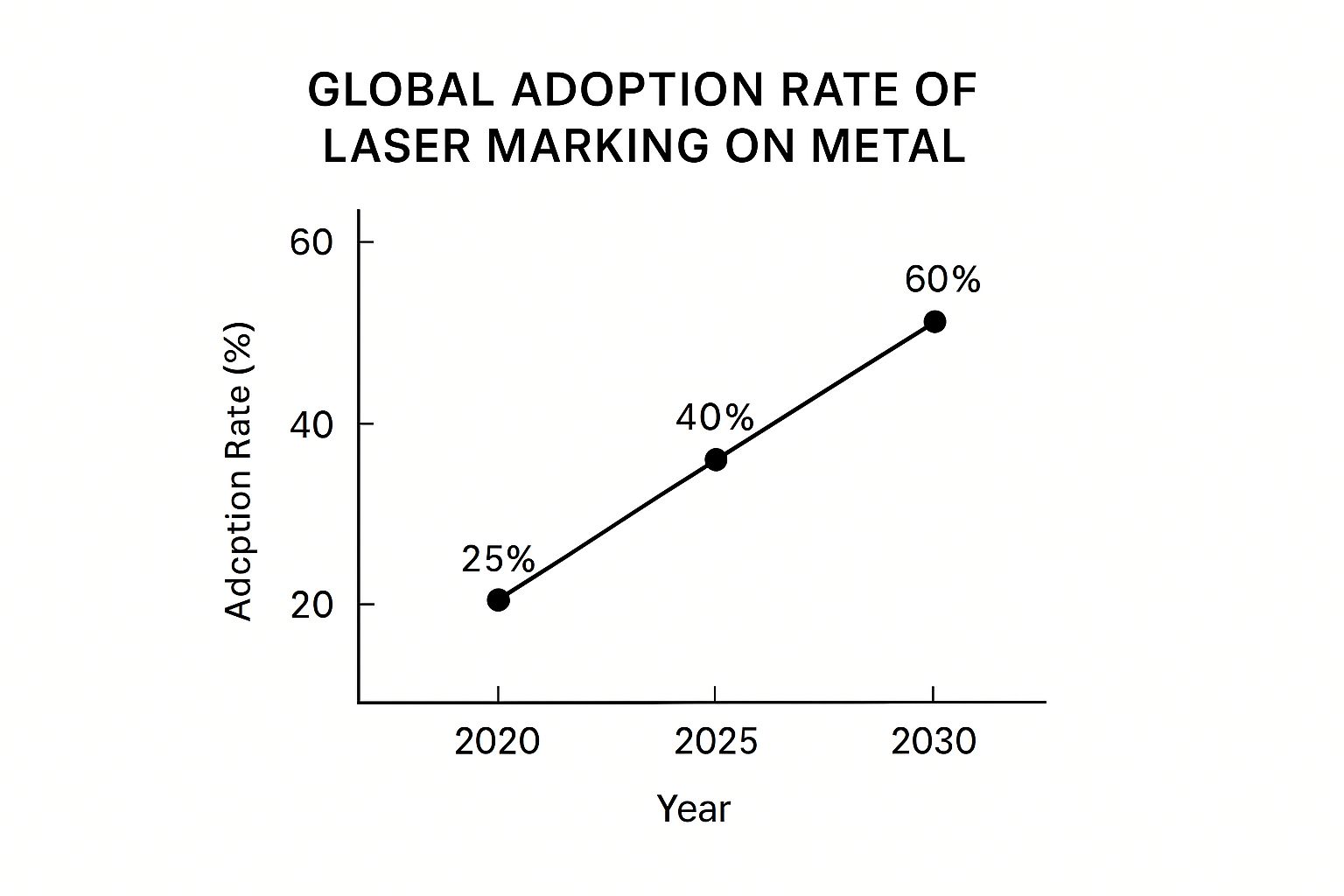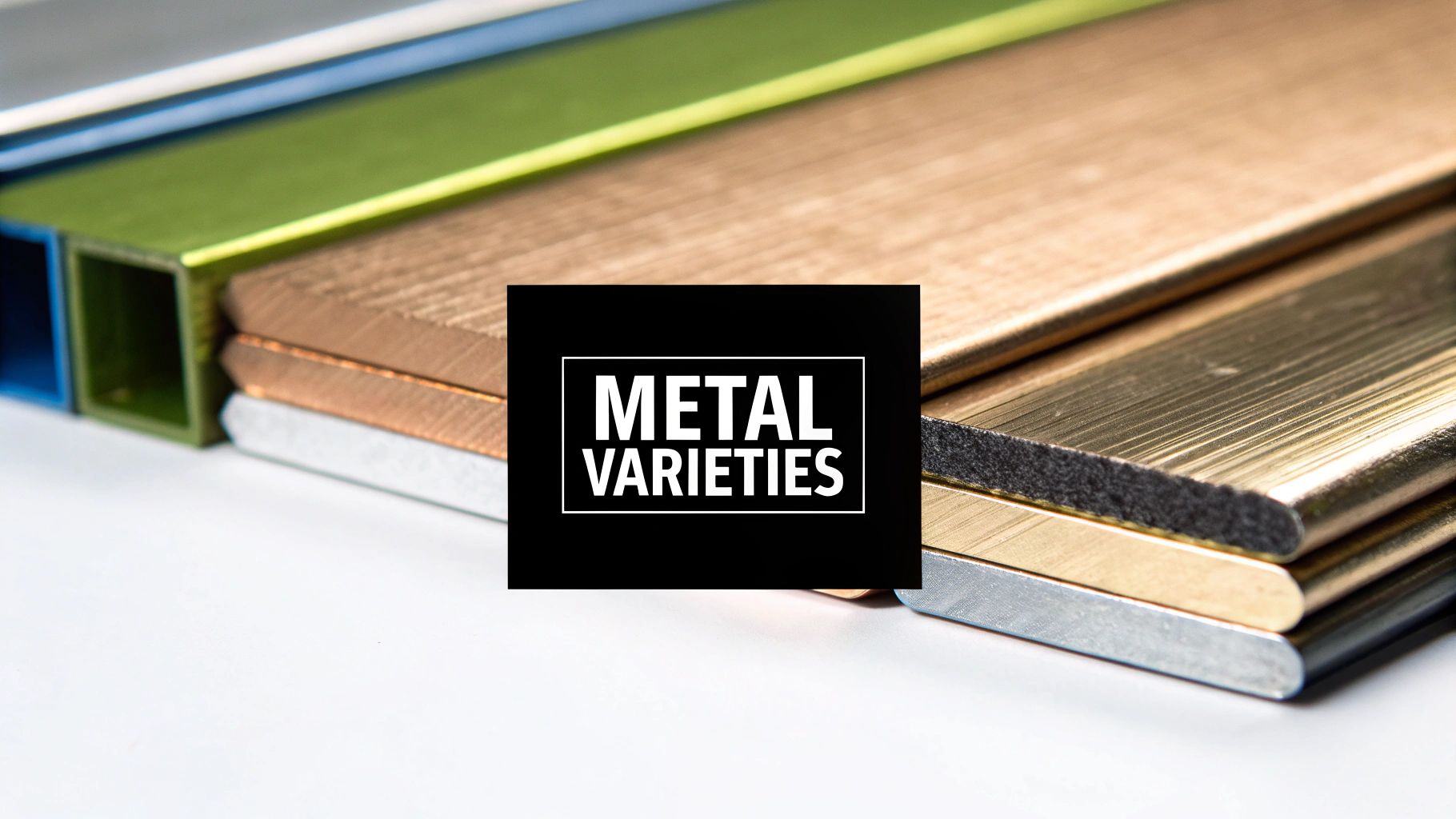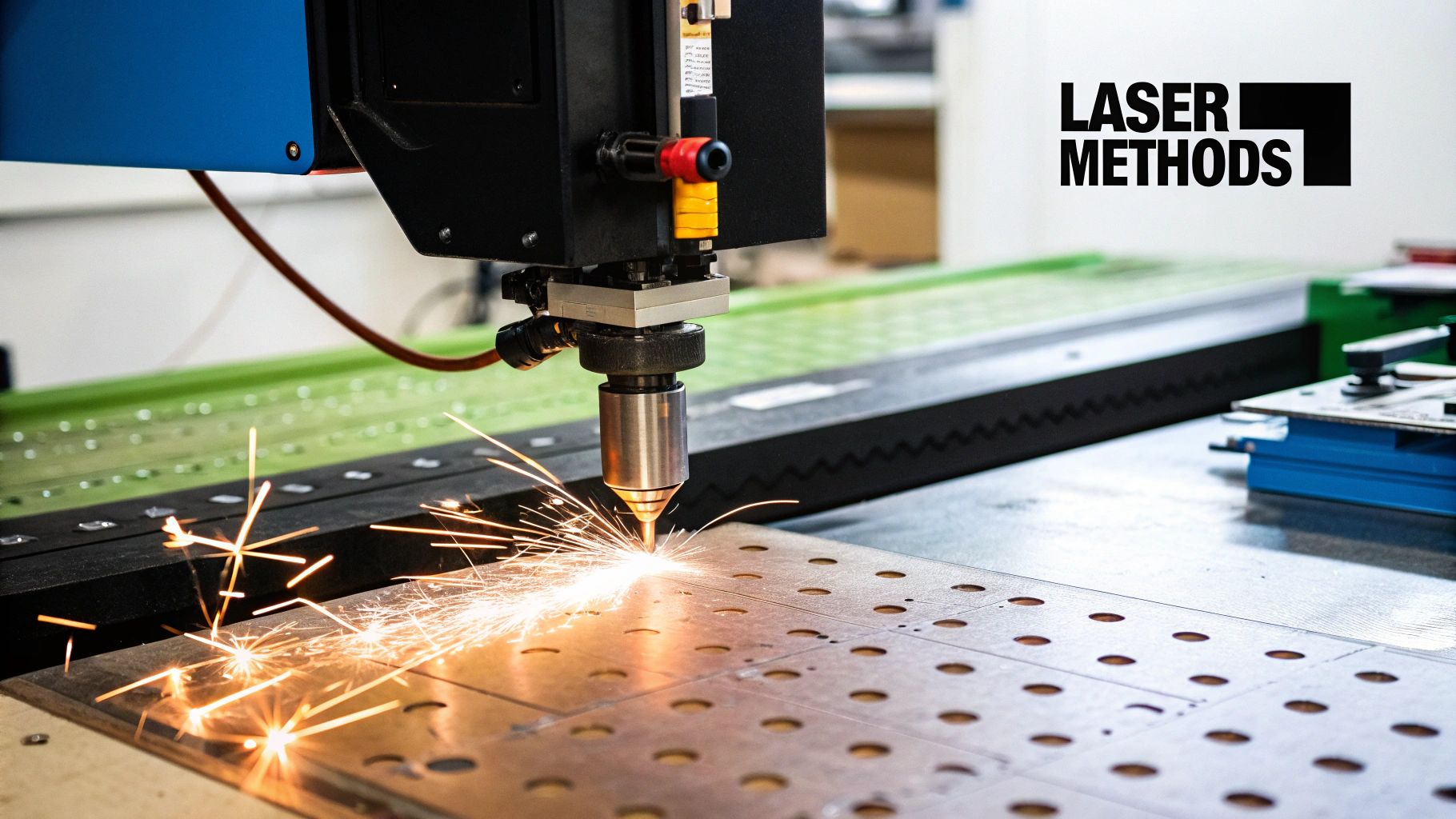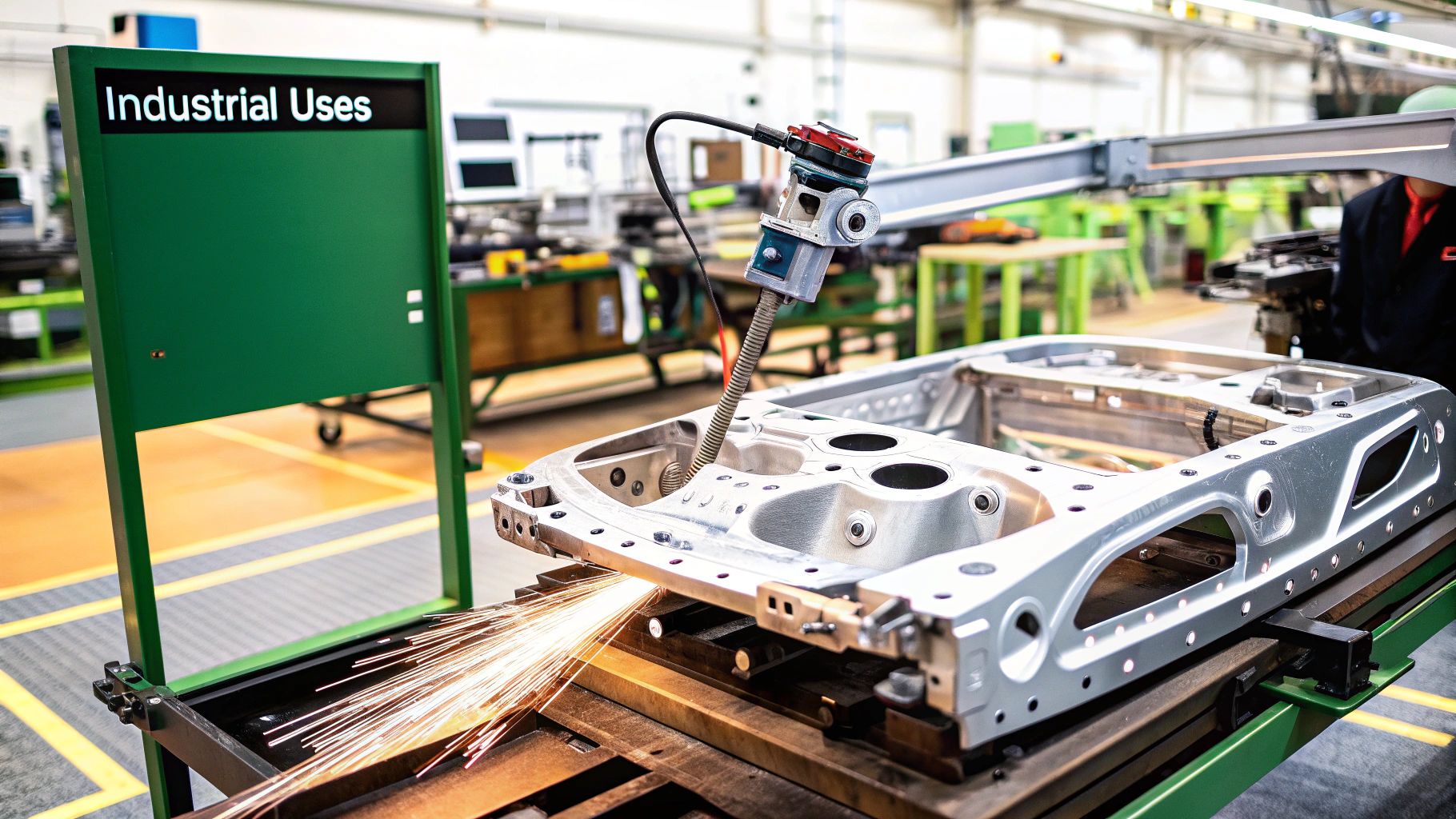Laser Marking on Metal: California Manufacturer's Guide
- Laserverse

- May 27
- 13 min read
Understanding What Makes Laser Marking on Metal Special
Laser marking on metal is rapidly becoming the preferred method for California manufacturers. It provides a level of precision and permanence that traditional methods simply can't match. Imagine trying to write your name on a metal plate with a pen. You might scratch the surface, but a laser can permanently alter the material itself. That's the power of this technology.

The infographic above shows the projected global adoption rate of laser marking on metal. Adoption is expected to increase significantly, from 25% in 2020 to a projected 60% by 2030. This growth highlights the increasing recognition of laser marking's benefits across various industries.
Key Advantages of Laser Marking
What makes laser marking so advantageous? Here are a few key benefits:
Durability: Laser markings are exceptionally resistant to wear and tear. This makes them ideal for harsh environments and applications that require long-term traceability. Unlike labels or paint, laser-etched marks won’t fade, peel, or be easily removed.
Precision: Laser marking allows for incredible detail and accuracy. This enables manufacturers to create complex designs, intricate patterns, and even microscopic markings on metal components. This level of precision is essential in industries like electronics and aerospace.
Speed and Efficiency: Laser marking is a fast and efficient process, often outpacing traditional methods like chemical etching or mechanical stamping. This leads to higher throughput and increased productivity.
Non-Contact Process: Because it's a non-contact method, laser marking eliminates the need to physically touch the metal surface. This reduces the risk of damage or contamination, which is particularly important for delicate components.
To better understand the advantages of laser marking, let's compare it to some traditional metal marking methods. The table below highlights the key differences in durability, precision, speed, and environmental impact.
Laser Marking vs. Traditional Metal Marking Methods
Method | Durability | Precision | Speed | Environmental Impact |
|---|---|---|---|---|
Laser Marking | Excellent | Very High | Very Fast | Low |
Chemical Etching | Moderate | Moderate | Slow | Moderate |
High | Moderate | Moderate | Low | |
Inkjet Printing | Low | High | Fast | Low |
As you can see, laser marking offers a superior combination of durability, precision, and speed while minimizing environmental impact. This makes it a highly attractive option for a wide range of applications.
Laser Marking vs. Engraving and Etching
While the terms "marking," "engraving," and "etching" are often used interchangeably, some key distinctions exist. Laser marking typically refers to a surface-level modification of the metal, like discoloration or annealing. Laser engraving involves removing material to create a deeper, more defined mark. Laser etching is similar to engraving, also removing material, but usually creates a shallower mark. The best technique depends on the specific application and desired outcome. For instance, surface annealing can create a color change on stainless steel for aesthetic purposes, while deep ablation engraving is suitable for permanent part identification on aircraft components. This flexibility allows California businesses to customize the process to their specific needs.
The Future of Laser Marking in California
California, with its focus on innovation and its concentration of high-tech industries, is leading the way in adopting laser marking technologies. From aerospace to medical devices, the demand for precise, durable, and efficient marking solutions is constantly increasing. Laser marking isn't just a passing trend; it represents a fundamental change in how manufacturers create permanent marks on metal, ensuring quality and traceability for the long term.
Why California Leads the Laser Marking Revolution

California is a major player in the laser marking industry. Several factors contribute to this leading position, including a strong presence of aerospace companies and a culture of innovation fueled by major tech companies. These industries maintain incredibly high standards, which in turn creates a need for advanced marking techniques. This pushes California manufacturers to constantly seek improvements in precision, durability, and efficiency. Laser marking on metal provides an ideal solution to meet these rigorous demands.
Aerospace and Tech: The Demand for Precision
The aerospace industry, with its stringent quality control and precise component marking requirements, has significantly shaped the development of laser marking. Consider the detailed markings on turbine blades or the minute serial numbers on electronic components. These necessitate a high degree of accuracy and permanence, something traditional methods often struggle to deliver. Silicon Valley's constant drive for miniaturization and high performance in electronics further necessitates precise and durable marking solutions for circuit boards and microchips. You might be interested in learning more about laser rust removal: How to master laser rust removal.
Regulation and Traceability: Turning Compliance into an Advantage
California's stringent regulatory environment, particularly regarding product traceability and safety, further contributes to the widespread adoption of laser marking. Regulations mandate permanent identification on specific parts, ensuring accountability and facilitating recalls if needed. Instead of viewing this as a burden, California manufacturers have embraced traceability as a competitive edge. They use laser marking to demonstrate their commitment to quality and regulatory compliance. This forward-thinking approach has established them as industry leaders.
The California Edge: Innovation and Skilled Workforce
Laser marking on metal has seen substantial growth in California, alongside the state's thriving manufacturing sector, especially within the aerospace and electronics industries. In 2023, California held approximately 15% of the U.S. market share in laser marking equipment sales, a testament to its advanced industrial foundation. More detailed statistics are available from Grand View Research: https://www.grandviewresearch.com/industry-analysis/laser-marking-machine-market. This growth isn't solely about meeting current needs; it's also about pioneering the next wave of marking technologies. California's skilled workforce and innovative spirit make it an ideal environment for testing new laser marking techniques and applications. This ongoing cycle of improvement ensures California maintains its position at the forefront of the laser marking revolution.
Selecting the Right Laser Technology for Your Metal

Choosing the right laser for marking metal is crucial for achieving optimal results. There's no single solution that fits every scenario. Different lasers excel at different tasks. This section explores the key differences between fiber, CO2, and diode lasers, empowering you to make an informed decision based on your specific needs. This involves understanding how each laser interacts with various metals and the resulting mark quality.
Understanding Wavelength and Its Impact on Metal Marking
The wavelength of a laser is a critical factor in determining its suitability for marking specific metals. For instance, fiber lasers, with their shorter wavelengths, are highly effective on metals like stainless steel, aluminum, and titanium. These metals absorb the fiber laser’s wavelength more efficiently, resulting in precise, high-contrast marks.
On the other hand, CO2 lasers, with their longer wavelengths, are better suited for marking certain coated metals or creating deeper engravings on other materials. They may require a marking spray for bare metals like steel or aluminum.
Fiber Lasers: Precision and Speed
Fiber lasers are renowned for their precision and speed. They excel at creating fine lines, intricate details, and permanent markings, making them ideal for applications like serializing parts, creating barcodes, and marking medical devices.
Imagine marking a tiny component inside a watch. A fiber laser can easily achieve this level of detail. Additionally, their high speed allows for faster production cycles, increasing output and efficiency.
CO2 Lasers: Versatility and Deep Engraving
CO2 lasers are valued for their versatility. While often needing a marking spray on bare metals, they can mark a wider variety of materials than fiber lasers, including plastics, wood, and glass.
CO2 lasers are also capable of creating deeper engravings, suitable for applications requiring high readability and durability. Consider marking a deep groove in a metal tool for improved grip – a task a CO2 laser can handle effectively.
Diode Lasers: Affordability and Specific Applications
Diode lasers, while generally lower in power than fiber or CO2 lasers, offer affordability and are suitable for specific applications. They are commonly used for light marking on metals, creating surface-level marks, and low-volume production.
This makes them a potential option for small businesses or hobbyists starting with laser marking. However, they may not be suitable for demanding industrial applications requiring high power or deep engravings.
Emerging Ultrashort Pulse Lasers: Opening New Possibilities
Emerging technologies like ultrashort pulse (USP) lasers are pushing the boundaries of laser marking. These lasers deliver incredibly short bursts of energy, enabling extremely precise micromachining and marking with minimal heat-affected zones.
This opens possibilities for delicate materials and highly intricate designs, particularly in electronics and medical device manufacturing. The benefits of USP technology are still being explored, but it represents the leading edge of laser marking on metal.
To help you choose the best laser for your needs, we've compiled a comparison table below:
Laser Types and Metal Compatibility Matrix: This table provides a comprehensive guide showcasing which laser types are most effective with different metals.
Metal Type | Fiber Laser | CO2 Laser | Diode Laser | Best Application |
|---|---|---|---|---|
Stainless Steel | Excellent | Good (with spray) | Fair | Serial numbers, barcodes |
Aluminum | Excellent | Good (with spray) | Fair | Data matrix codes, part identification |
Titanium | Excellent | Fair | Poor | Medical implants, aerospace components |
Mild Steel | Good | Good (with spray) | Fair | Industrial markings, branding |
By considering these factors and understanding the nuances of each laser technology, you can select the ideal system to meet your specific metal marking requirements, improve efficiency, and enhance product quality. This careful selection process is a key investment for maximizing the return on your laser marking endeavors.
Real Applications in Aerospace and Electronics Manufacturing
California's demanding aerospace and electronics manufacturing sectors require precise and durable marking solutions. Laser marking on metal has become indispensable in these industries, addressing critical challenges from microscopic component identification to withstanding extreme environments. This section explores how laser marking solves real-world production problems and empowers manufacturers to meet stringent quality standards.
Traceability and Component Identification in Aerospace
The aerospace industry relies heavily on laser marking for traceability and component identification. Every part, from the smallest fastener to massive engine components, requires permanent and readily visible markings. This ensures that components can be tracked throughout their entire lifecycle, crucial for maintenance, repairs, and safety investigations.
Laser marking allows the creation of unique identifiers like serial numbers, 2D data matrix codes, and even intricate logos directly onto metal parts. These markings withstand harsh conditions, including extreme temperatures, pressure fluctuations, and chemical exposure, guaranteeing long-term readability and dependable identification.
For example, aircraft engine components often require permanent identification that can survive extreme operating conditions. Laser marking offers the necessary durability and precision for this demanding application. The ability to mark intricate details also allows manufacturers to include more information on each part, streamlining maintenance and repair processes.
Micro-Marking in Electronics Manufacturing
In electronics manufacturing, laser marking enables micro-marking of semiconductor packages, circuit boards, and other miniature components. The precision of laser marking allows for incredibly fine text, complex patterns, and even microscopic 2D codes on these tiny surfaces.
This detail level is essential for identifying and tracking individual components, improving quality control and simplifying repairs. The non-contact nature of laser marking also ensures that delicate electronic components remain undamaged during the marking process.
Meeting Regulatory Compliance and Optimizing Supply Chains
Laser marking on metal helps manufacturers meet strict regulatory compliance standards. Clear, permanent markings facilitate traceability, vital for product recalls, quality assurance, and compliance with industry regulations.
Laser marking also improves supply chain optimization by enabling effective inventory management and part tracking throughout manufacturing and distribution. This enhanced traceability also combats counterfeiting, a major concern in both aerospace and electronics.
High-Volume Production and Quality Control
The speed and efficiency of laser marking are essential for high-volume production. Laser marking systems can mark thousands of parts per hour without sacrificing the exacting quality these sectors demand. This efficiency reduces production time and lowers overall manufacturing costs.
Furthermore, laser marking facilitates automated quality control processes, guaranteeing that every marked component meets specifications. Check out our guide on industrial laser cleaning: Learn more about industrial laser cleaning.
Pushing the Limits of Laser Marking Technology
The constant drive for miniaturization and increased performance in aerospace and electronics fuels continuous innovation in laser marking technology. Ultra-fine marking on semiconductor packages and complex designs on aircraft engine components are just two examples of how these industries push the boundaries of laser marking on metal. These advancements improve marking efficiency and precision while creating new possibilities for component identification, traceability, and even product customization.
Achieving Consistent Quality While Maximizing Speed

Achieving high-quality laser marking on metal requires a delicate balance between speed and precision. It's akin to driving a race car – you strive for maximum speed while maintaining control. This section explores the key parameters influencing both, offering practical guidance for professional results on every component. We'll examine power settings, scan speed, frequency, and focal positioning. You may also find this resource helpful: How to master laser cleaning.
Power Settings: Finding the Right Balance
Laser power significantly impacts mark depth and contrast. Insufficient power results in a faint mark, while excessive power can damage the metal or cause unwanted heat effects. The ideal power setting varies depending on the metal type, desired mark depth, and the type of laser used (fiber, CO2, or diode).
For instance, marking stainless steel with a fiber laser may require higher power than marking aluminum with the same laser. Finding the optimal power level involves experimentation and careful observation. Begin with a lower setting and gradually increase until the desired mark quality is achieved.
Scan Speed and Frequency: The Dynamic Duo
Scan speed (how quickly the laser traverses the metal) and frequency (the laser's pulse rate) are closely related. Increasing scan speed can boost throughput, but it can also lighten the mark if the frequency isn't adjusted.
Consider drawing a line quickly with a pen – a light touch produces a faint line. Similarly, high scan speed with low frequency can result in a shallow mark. Balancing these parameters is crucial for consistent quality at higher speeds.
Focus Positioning: The Key to Sharpness
Focus dictates the laser beam's concentration at the metal's surface. A precisely focused beam creates a sharp, well-defined mark, whereas an out-of-focus beam results in a blurry or uneven mark. The ideal focus depends on the desired mark characteristics and the metal being marked.
Visualize a magnifying glass focusing sunlight to burn paper. The sharper the focus, the greater the heat intensity. Similarly, precise focus in laser marking is essential for achieving the desired quality and depth.
Process Control and Measurement: Maintaining Consistency
Consistent quality during production requires rigorous process control. This involves regularly monitoring parameters like laser power, scan speed, and focus. Implementing measurement strategies, such as microscopic examination of marked parts, helps identify potential issues early.
Even slight power variations can affect mark depth. Regular monitoring and adjustments ensure consistent results. This proactive approach maintains quality, reduces scrap, and optimizes production efficiency. By mastering these techniques, manufacturers can achieve the essential balance of quality and speed in laser marking.
Environmental Benefits That Impact Your Bottom Line
Laser marking on metal offers significant environmental advantages along with its impressive performance. These benefits translate directly into cost savings for California manufacturers, creating a win-win situation for both the environment and your profits. This section explores how laser marking reduces hazardous waste, minimizes energy consumption, and contributes to a safer work environment.
Eliminating Chemical Etchants and Their Associated Costs
Traditional marking methods like chemical etching use hazardous substances that require careful handling and disposal. These chemicals present risks to both employee health and the environment. Laser marking, a non-contact process, eliminates the need for these etchants completely.
This means no more purchasing, storing, or disposing of hazardous chemicals, leading to significant cost reductions and a safer workplace. This shift reduces the risk of environmental contamination and lowers your company’s environmental footprint.
Reducing Waste Disposal Fees: A Financial and Environmental Win
The absence of chemical etchants and the minimal waste produced by laser marking drastically cut disposal fees. This presents a significant advantage over traditional methods, which generate considerable waste requiring specialized, and often expensive, disposal procedures.
For instance, companies using chemical etching must pay for the proper disposal of spent chemicals and contaminated materials. With laser marking, this cost is virtually eliminated. This not only improves your bottom line but also demonstrates your company’s commitment to environmental responsibility, appealing to environmentally conscious customers and investors.
Lowering Operational Costs Through Energy Efficiency
Modern laser marking systems are impressively energy-efficient. They consume significantly less power than traditional marking methods, resulting in lower electricity bills. Older methods like sandblasting or mechanical engraving, for example, can require high-powered compressors and other energy-intensive equipment.
The precision and speed of laser marking further contribute to energy savings. The focused laser beam minimizes wasted energy, and quick marking times reduce the equipment's overall operating time. This increased efficiency contributes to a smaller carbon footprint and helps your business comply with California's stringent environmental regulations.
Case Studies: Real-World Examples of Sustainable Savings
Many California manufacturers have transitioned to laser marking and are experiencing the environmental and financial benefits. Some companies report substantial reductions in their hazardous waste disposal costs, while others have noticed significant decreases in their energy consumption.
These real-world examples highlight the tangible benefits of laser marking and its positive impact on both sustainability and profitability. These successes not only validate the technology but also encourage other manufacturers to adopt a more environmentally sound approach.
Contributing to a Safer Work Environment
Beyond environmental advantages, laser marking fosters a safer and healthier workplace. By eliminating the need for hazardous chemicals, laser marking reduces the risk of chemical exposure and related health problems for employees.
This creates a more positive work environment and can potentially lower worker’s compensation costs. Additionally, the reduced noise levels compared to some traditional marking methods contribute to a more comfortable and productive workspace. This emphasis on employee well-being aligns with corporate social responsibility initiatives, further enhancing your company's reputation.
By adopting laser marking, California manufacturers can showcase their dedication to environmental sustainability while improving their bottom line. This dual benefit positions laser marking as a proactive solution that aligns with both profit goals and responsible environmental practices.
Your Implementation Roadmap for Laser Marking Success
Transforming your metal marking operations with laser technology requires careful planning. This roadmap outlines the crucial steps for successful implementation, ensuring a smooth transition, optimal results, minimized risks, and maximized return on investment.
Initial Assessment and ROI Calculation
A comprehensive needs assessment is essential before implementing laser marking on metal. This involves evaluating your current marking processes, identifying areas for improvement, and defining specific requirements.
For example, if you currently use chemical etching, analyze its costs, including materials, disposal, and potential environmental impact. Compare these costs with the projected expenses of laser marking to understand the potential return on investment (ROI).
Calculating ROI is crucial for justifying the investment in new technology. Consider factors like increased throughput, reduced material waste, and lower operating costs.
Equipment Selection: Choosing the Right Laser
Selecting the right laser marking system is critical. Different lasers excel at various tasks and metal types. Understanding these differences is vital for choosing a system that meets your specific needs.
Fiber lasers: Ideal for stainless steel, aluminum, and titanium, offering high precision and speed.
CO2 lasers: Suitable for coated metals and deeper engravings, offering versatility across various materials.
Diode lasers: Cost-effective for light marking and low-volume production.
Consider the types of metal you work with, the required marking depth, and your daily marking volume.
Integration and Training: Seamless Transition
Integrating the laser marking system into your production line is crucial for minimizing disruption. Plan for the physical space, power needs, and compatibility with current workflows.
Proper training is equally important. Operators must be proficient in using the new system, including software, parameter adjustment, and safety procedures.
Hands-on training: Provide practical experience on real parts.
Software training: Focus on design creation, parameter settings, and data management.
Maintenance training: Equip staff to perform basic maintenance and identify potential issues.
Timeline and Benchmarks: Measuring Success
Establish a realistic timeline for implementation, including equipment delivery, installation, training, and initial production runs. Setting clear performance benchmarks helps track progress and measure success.
For example, aim for a specific increase in parts marked per hour or a reduction in the scrap rate. Tracking these metrics provides valuable insights into the laser system’s performance.
Maintenance and Key Performance Indicators (KPIs)
Preventative maintenance ensures long-term reliability, avoids downtime, and minimizes costly repairs.
Identify Key Performance Indicators (KPIs) to track your success. These can include:
Marking speed: Parts marked per hour.
Mark quality: Consistency, depth, and readability.
Uptime: Percentage of operational time.
Cost per mark: Including materials, labor, and maintenance.
Monitoring these KPIs helps identify areas for improvement and optimize the laser marking process.
Budget and Change Management
Your budget should encompass the purchase price, installation, training, and ongoing maintenance. A realistic budget is key for securing stakeholder buy-in and managing expectations.
Implementing new technology requires effective change management. Communicate the benefits of laser marking to your team, address concerns, and provide support throughout the transition. This ensures a smooth switch and optimizes the impact on your business.
Contact Laserverse today at https://www.laserverse.ca to explore how our advanced laser solutions can elevate your operations.

